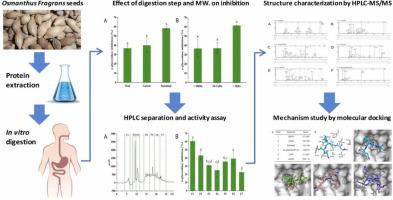Activity and mechanism of α-glucosidase inhibitory peptides released from Osmanthus fragrans seeds protein during the in vitro digestion
Abstract
Osmanthus fragrans seeds (OFSs) abundant in protein are valuable resources of bioactive peptides. To elucidate the potential hypoglycemic peptides released during the digestion, OFSs protein was extracted and digested in vitro. The effects of the digestion step and molecular weight on the α-glucosidase inhibitory ability of the digested protein were evaluated, and the mechanism and structure of the main effective peptides in the digesta were studied. The results indicated that the digesta after the small intestine digestion displayed higher inhibition (58.5 %), from which the fraction below 3 kDa was more effective (67.34 %). Among the seven sub-fractions (F1∼F7) below 3 kDa, F1 obtained the highest α-glucosidase inhibitory ability (60.69 %). Three peptides (ERFQ, VHHK, and EKFMKE) were identified from F1, and their efficacy was verified by corresponding synthetic peptides, showing the α-glucosidase inhibitory rates of 79.1 % ± 2.24 %, 65.67 % ± 1.97 % and 61.94 % ± 1.97 %, respectively. According to the molecular docking, these peptides inhibited the α-glucosidase by forming secondary forces (e.g. hydrophobic interaction) with the key amino acids (e.g. D327, D443, Y299, and F575) of the enzyme, with docking scores ranging from −151.038 to −171.907. This study demonstrated OFSs could release α-glucosidase inhibitory peptides during digestion and may serve as functional ingredients to control diabetes.


| 公司名称 | 产品信息 | 采购帮参考价格 |
|---|---|---|
| 麦克林 |
n-Hexane
|
¥22.00~¥105656.00 |
| 阿拉丁 |
pepsin
|
¥32.00~¥98370.53 |
| 麦克林 |
acarbose
|
¥60.00~¥73673.00 |
| 麦克林 |
ethanol
|
¥14.00~¥34800.90 |
| 阿拉丁 |
pancreatin
|
¥23.00~¥6537.28 |
| 麦克林 |
porcine bile salt
|
¥17.00~¥3895.00 |
| 阿拉丁 |
4-Nitrophenyl-?2-D-pyranoside glucoside
|
 求助内容:
求助内容: 应助结果提醒方式:
应助结果提醒方式:


